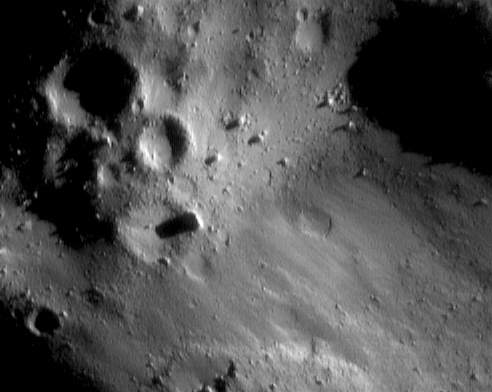How Collisions Shaped an Asteroid

Next Fourth of July, NASA will slam a heavy probe the size of a garbage can into a comet, purposely carving a football-field sized crater for inspection. As for what exactly will happen, however, nobody really knows.
Despite several close-up examinations of comets and asteroids in recent years, including NASA's dramatic landing of the NEAR Shoemaker spacecraft on Eros in 2001, the makeup of space rocks remains largely undetermined. Scientists aren't even sure what structural and chemical differences separate comets and asteroids.
In particular, astronomers would like to know how solid or loosely packed asteroids are. That will help them better understand the history of the solar system. It'd also come in handy if we ever need to deflect or destroy one that's headed our way.
Case study
A new study of Eros provides further insight into its structure by modeling how impacts by other asteroids likely rung its bell. The model supports previous work that maintains Eros, a potato-shaped rock 21 miles (33 kilometers) long, is not solid, but rather a fractured set of blocks, each as big as a small town.
The many craters on Eros represent a record of its violent past. Initial studies of NEAR pictures and data suggested it was probably once a single block of rock, but over millions of years collisions with smaller asteroids fractured it, explains University of Arizona researcher James Richardson Jr.
The blocks, each miles wide, fit like a 3-D jigsaw puzzle and are held together by their collective, albeit weak gravity.
Get the Space.com Newsletter
Breaking space news, the latest updates on rocket launches, skywatching events and more!
In the new work, Richardson assumed this structure and plugged it into a computer model of seismic activity. The results seem to explain how previous craters on the asteroid get obscured and washed out by the shaking that follows an impact.
"When a small asteroid strikes a much larger one, such as Eros, it will have four major effects on the surface and structure of the larger asteroid," Richardson told SPACE.com.
- A crater is carved in the target asteroid's surface.
- A thin layer of debris spreads over the target asteroid, mostly concentrated near the impact site; some debris is lost to space.
- Underlying bedrock is fractured.
- The asteroid rattles as seismic waves reverberate through it; shaking can last several minutes to an hour or so.
Just like Eros
Though the computer model is not meant to show all the outcomes of regolith migrating down slopes, it does demonstrate a mechanism for creating slumps, avalanches, and the pooling of regolith in low areas. Also, it properly simulates the degradation and erasure of small impact craters, Richardson said. These are all features seen on Eros.

The computer model employed impacting rocks from 2.2 feet (0.7 meters) to nearly a half-mile (700 meters) in diameter. It created virtual craters from 66 feet (20 meters) to 12.4 miles (20 kilometers) wide.
The study should apply to all rocky, fractured asteroids up to about 62 miles (100 kilometers) in diameter, Richardson said.
Thing is, scientists don't know how many asteroids are like this. Other space rocks might be more like loose rubble piles, with no large blocks. Still others might be solid as a rock. And the seismic effects will vary by the size of the asteroid that's hit.
"Larger asteroids will experience only local seismic effects following impacts, not global seismic effects, due to their larger volumes and higher gravities," Richardson said. "Highly porous or extremely fractured asteroids will diminish [or attenuate] seismic waves more effectively and will therefore experience less seismic shaking from impacts as compared to their more lightly fractured, rocky counterparts."
Next: Go there
The improved grasp on asteroid shaking could help scientists plan for actual seismic studies of the objects, so scientists can finally figured out how asteroids are really structured.
Richardson's study, reported in Friday's issue of the journal Science, has "set the stage for a detailed geomechanical understanding of small planetary bodies," said Erik Asphaug of the University of California, Santa Cruz. Asphaug wrote a review of the work for the journal.
A handful of missions are in the works to explore the interiors of asteroids and comets. One problem, Asphaug writes, is keeping a probe affixed to an object that has almost no gravity. Among the solutions.
- The European Space Agency's Rosetta spacecraft is on it way to comet 67/P Churyumov-Gerasimenko, where it will set anchor with harpoons, then use radio waves to explore the interior.
- The Japanese Hayabusa spacecraft is expected to reach asteroid 25143 Itokawa the middle of next year; it will touch the asteroid's surface and fire a small bullet, knocking grains into a canister for return to Earth.
- NASA's Deep Impact mission will fire a 770-pound (350-kilogram) projectile into comet Tempel 1, photograph the impact and analyze the fresh crater.
- NASA's Dawn mission, set for launch in 2006, will orbit asteroid Ceres, the largest known asteroid with a diameter of 578 miles (930 kilometers).
- The Confusing Outer Solar System
- Some Asteroids are Like Onions
Join our Space Forums to keep talking space on the latest missions, night sky and more! And if you have a news tip, correction or comment, let us know at: community@space.com.

Rob has been producing internet content since the mid-1990s. He was a writer, editor and Director of Site Operations at Space.com starting in 1999. He served as Managing Editor of LiveScience since its launch in 2004. He then oversaw news operations for the Space.com's then-parent company TechMediaNetwork's growing suite of technology, science and business news sites. Prior to joining the company, Rob was an editor at The Star-Ledger in New Jersey. He has a journalism degree from Humboldt State University in California, is an author and also writes for Medium.









